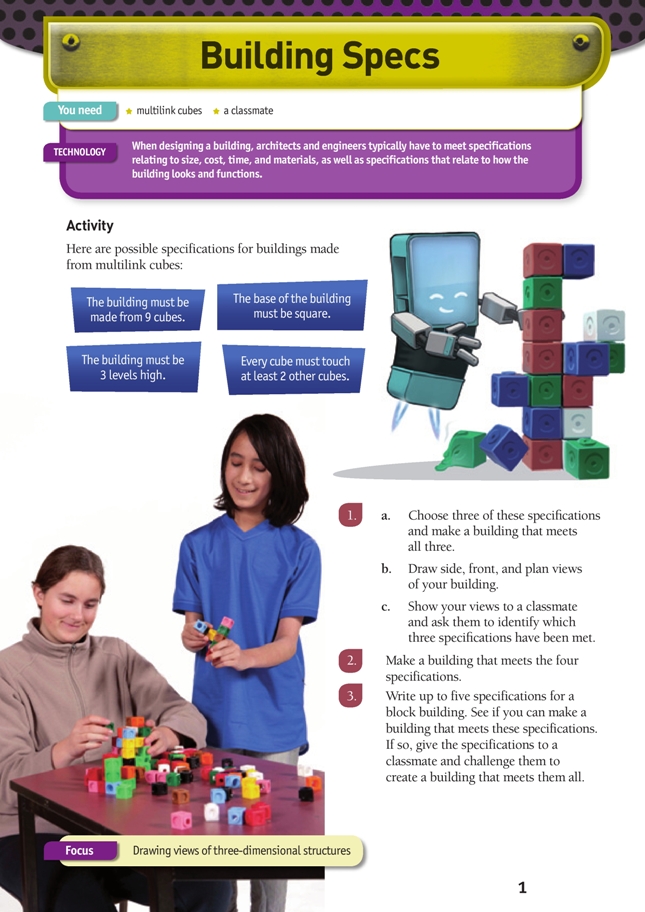This is a level 4 activity from the Figure It Out series.
A PDF of the student activity is included.
Click on the image to enlarge it. Click again to close. Download PDF (403 KB)
Spatial-visualisation skills are important in many technical and scientific occupations. Reading, making, and using diagrams are good ways for students to develop these skills.
In this activity, students make “buildings” that meet certain specifications and then draw visual representations of the buildings they create.
multilink cubes
a classmate
Many students enjoy working with multilink cubes. Spatial skills are needed to draw two-dimensional representations of three-dimensional objects. Closing one eye when viewing the building from the side, top, or front can help students to “see” the view as two-dimensional, making it easier to draw.
Most students will need to make the buildings shown in their classmate’s drawings in order to identify which specifications have been met. Students with highly-developed spatial skills may be able to use visualisation alone.
Related activities from the Figure It Out series include Cube Creations (page 13) and Building Boldly (page 14) in the level 3–4 Geometry book.
Creating two-dimensional representations of three-dimensional objects develops the key competency using language, symbols, and texts.
Extension
Show students how to create drawings of buildings on isometric dot paper. Isometric paper is readily available on the Internet. See A Chip off the Old Block (Geometry, level 3, page 10) for a good introductory activity.
Support for English Language Learners
Supporting students with the language needed to express obligations
English language learners may benefit from support with understanding and expressing obligation using must and mustn’t.
Discuss specifications and provide examples of stated requirements, for example, Your presentation must be …, Your project must have … Ask the students which word signals that the requirements are compulsory. Draw attention to the use of must + base form of the verb and note that, in this context, the main verb is usually be or have. Prompt students to provide further examples from a range of contexts. Include the negative form mustn’t.
Students who need a lot of support with writing specifications may benefit from sentence starters.
For example:
The building must be ____________________________
The building must have __________________________
It’s a good idea to use only one or two ways of expressing obligation at a time and not a range of contrasting meanings and forms (for example, structures with can, may, or should). In addition, note that structures with must can also express probability but, again, it’s generally most useful to focus on one meaning at a time.
Technology-related student activities
- Research items such as cars, cameras, and watches to increase awareness of what is meant by technical specifications.
- Build a bridge that meets certain specifications (see www.wow4water.net/grownups/resources/8).
Exploring the technology-related context
Some people confuse attributes with specifications. Attributes are the general properties of a product. A coat can be waterproof, warm, or colourful. A car can be fuel-efficient and a meal can be nutritious. Specifications are measurable. A camera may have 4.9 million effective pixels, an aeroplane engine may produce 160 horsepower, and a biscuit may have 280 kilojoules. Attributes and specifications are linked. For instance, to evaluate the healthiness of a meal, a dietician could identify the kilojoule, salt, and fat content.
Answers to activity
1.–3. Practical activity
